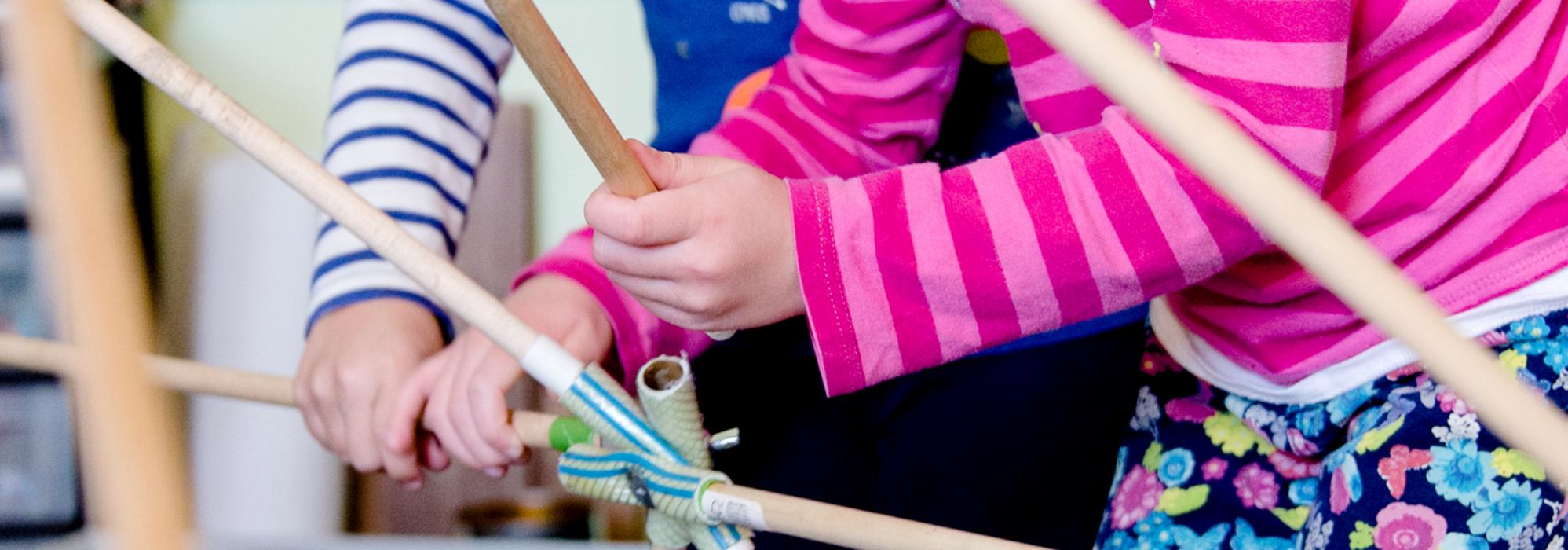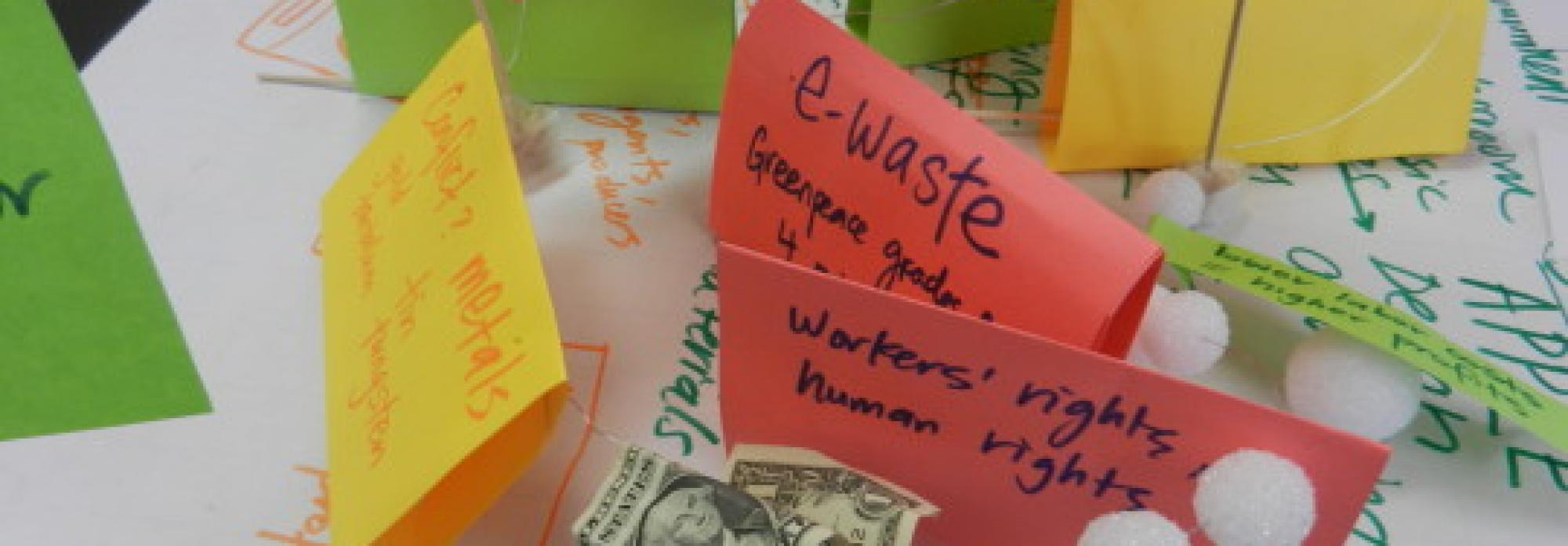
Maker Empowerment Revisited
Agency by Design Principal Investigator Shari Tishman takes a dispositional approach to redefining “maker empowerment.”
A few months ago, we wrote a blog post about the concept of maker empowerment that provoked a wonderful online discussion. Since then we’ve continued to think about this concept. Our thinking has been greatly informed by the many insightful comments on the post, and also by some prior research at Harvard Project Zero. So we’re at it again. In a moment we share a slightly revised version of the definition, along with some notes about what’s new in it and what’s not. But first, a couple of general remarks…
The big idea behind the concept of maker empowerment is to describe a kind of disposition—a way of being in the world—that is characterized by seeing the designed world as malleable, and understanding oneself as a person of resourcefulness who can muster the wherewithal to change things through making.
The concept of maker empowerment is meant to be somewhat broader than the label of maker. It certainly includes maker-types—i.e., hackers, DIYers, and hobbyists—but it also includes people who may not define themselves as wholly as makers, yet take the initiative to engage in maker activities from time to time. For example, it includes the person who doesn’t think of herself as a maker, but after she purchases a new laptop computer, she envisions the perfect laptop cover and endeavors to design and make it rather than purchasing it from a store. It also includes the teens who may not think of themselves as DIYers, but frequent thrift stores in order to find garments they can hack and combine to make stylish new looks, and the girl who eagerly scours the internet for instructions on how to make a potato launcher rather than purchasing a ready-made potato cannon online.
From the standpoint of education, the notion of empowerment is behind much of what we teach. We teach art, or history, or auto mechanics not solely to train practitioners of these crafts, but to help all students develop the capacity to engage with world through the lenses of these disciplines—even if not all students will become artists or historians or auto mechanics. The concept of maker empowerment aims for this same breadth.
Maker Empowerment Version 2
Thanks to the input of our blog commentators, here’s another take on a definition. For the sake of comparison, we give the earlier version first.
Maker Empowerment (v1): A heightened sensitivity to the made dimension of things and systems, along with a nudge toward tinkering with them and an increased capacity to do so.
Maker empowerment (v2): A sensitivity to the designed dimension of objects and systems, along with the inclination and capacity to shape one’s world through building, tinkering, re/designing, or hacking.
One readily apparent difference is that in version two the word nudge is gone. The word was interpreted as implying the necessity of a third party, an external agent, to prod or push people into maker activity. We definitely don’t want to imply that! In fact, it’s contrary to one of the main purposes of the Agency by Design project, which is to understand how maker activities can develop students’ sense of agency or self-efficacy. So nudge has been nudged out.
Though we’ve removed nudge, we’ve retained the word empowerment. There has been some very thoughtful commentary on our blog about this term and its social-movement connotations of the powerful giving power to the unempowered and thus retaining the status quo hierarchies of privilege and access. We agree that this connotation isn’t exactly what we’re looking for. Our hope is to reclaim a slightly different connotation in which empower refers to the driving force that comes from within—a personal sense of agency. This seems to be what people have in mind when they talk about how the maker movement can empower people to shift from being passive consumers of their world to being active producers or collaborators.
We’ve also retained the three-part construction of the concept that emphasizes sensitivity, inclination (previously the doomed “nudge”), and capacity. We’ve even made this dimension more explicit. Herein is the connection to the Project Zero research I mentioned at the beginning of this post. Project Zero has a long line of inquiry around “thinking dispositions” that aims to explain how habits of mind develop. This work is relevant to our definitional attempts here because maker empowerment is a dispositional concept. That is, rather than simply naming a set of technical skills, it aims to describe a mindset, along with a habitual way of engaging with the world.
Thinking Dispositions and Maker Empowerment
A thinking disposition is an abiding pattern of intellectual behavior. For instance we might talk about people having a curious disposition, a reasonable disposition, an intellectually playful disposition. As an example, consider the disposition toward open-mindedness. People we label as open-minded tend to have a distinctive and dependable mindset that flavors their engagement with the world: They have a tendency to try to look at things in new ways (inclination), they are alert to occasions to explore new perspectives (sensitivity); and they are skilled at recognizing hidden assumptions and challenging existing paradigms (ability). As it happens, this analysis applies not just to habits of mind (thinking dispositions) but to all kinds of dispositional behavior. The concept of maker empowerment is a dispositional concept, and the v2 definition makes these three dispositional components explicit: It emphasizes a sensitivity to the designed dimension of the world, along with the inclination to engage with the world through making, and the capacity (or ability) to do so.

You may be thinking that this sounds good in theory but maybe that’s all it is—just a theory. And at first you would have been right. But several years ago Project Zero was able to do some proof-of-concept research to see whether this three-part analysis of dispositions actually explained reality. In other words, we tried to find out whether we could find empirical evidence of these three distinct components at work in young people’s cognitive processes.
Through a series of rather elaborate experiments, we were able to show that the contribution of these three elements—ability, inclination, sensitivity—could indeed be individually distinguished in patterns of thinking and that a shortfall in any of the three elements would block cognitive performance. (If you enjoy getting technical, you can read about the research here.)
Now here’s where it gets interesting. It turns out that the biggest bottleneck in behavior—in other words, the shortfall that most frequently prevents inclination, ability, and sensitivity from coalescing into sustained cognitive activity—is a shortfall of sensitivity. In other words, at least in terms of critical and creative thinking, young people don’t follow through with these habits of mind not because they can’t (ability), and not because they don’t want to (inclination), but mainly because they don’t notice opportunities to do so. This doesn’t mean that young people’s inner detection mechanisms are woefully flawed. Sensitivity has everything to do with the saliency of cues in the environment. If an environment doesn’t have strong cues toward certain pattern of behavior—or actually contains counter-cues—it can be pretty hard for those patterns of behaviors to be cued up. No surprise, perhaps, that we found that students had difficulty picking up cues to think critically and creatively for themselves when they’re steeped in a traditional school culture that doesn’t necessarily encourage out-of-the-box thinking or thinking for oneself.
Of course, the research I’ve just described wasn’t conducted with the disposition toward maker empowerment in mind. So we don’t know if the findings about sensitivity transfer. But it’s easy to see that there are lots of cues in our everyday environment not to be a maker: The endless stream of cheap, ready-made objects; a culture of disposable goods; little time or valuing of prolonged tinkering. Maker culture is different of course. What goes on inside maker spaces and in maker classrooms is usually just the opposite. But the challenge is expanding maker values into the mainstream.
Even if you like the idea of maker empowerment, you may be wondering what purpose a three-part dispositional analysis of the concept serves. It sounds rather technical, and clearly it’s not necessary in order to effectively teach or learn maker thinking (think of all the great maker education programs that currently exist). Perhaps it can be compared to an analysis of the biomechanics of walking. You don’t need to understand the biomechanics of walking in order to be able to walk. And you don’t even need to understand them in order to teach a child to walk. But if there's an obstacle along the way, either in the learner’s own capacity or in the learning environment, then knowing the biomechanics can be useful. As the maker movement continues to infiltrate mainstream education, a dispositional analysis of maker empowerment might serve as a similarly useful tool.






